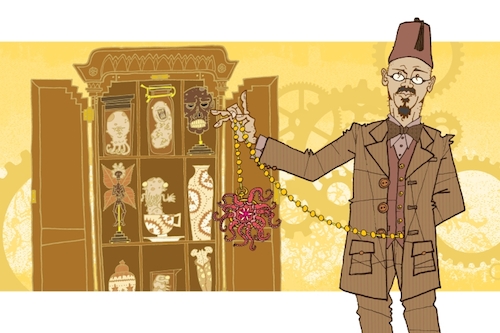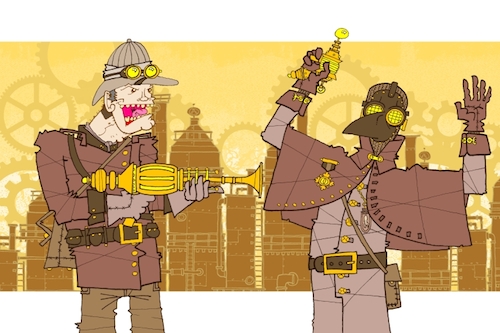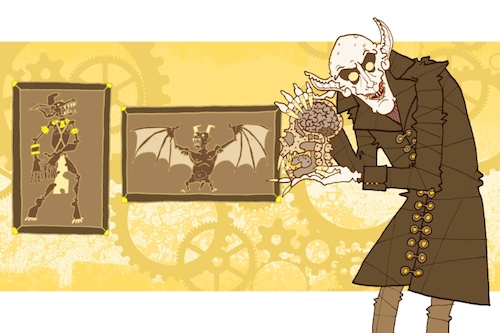Visual Arts Poster Bot — March 24, 2015 9:58 — 0 Comments
The Head Of Nosferatu: An Interview With Artist Tony Hicks
In December of 2014 The Mourning Market hosted it’s semi regular bizarre at El Corazon in Eastlake, it was through this collection of eccentric curators and dark-artists that I was first introduced to the work Of Mr. Shamus Tinplate, AKA Tony Hicks of Tinplate Studios. He’s like a cuddly cross between Ming The Merciless and Professor Frink; using wire, Super Sculpey and Japanese mulberry-paper to create a bestiary of canned-cryptids, mummified faeries and teacups swimming with octosapien monsters.
Inspired by 19th century Wunderkammers, Tony is now the proprietor of his own 21st century Etsy site, but you don’t have to follow him on Etsy to find his work… He’s been a featured artist in The Georgetown Art Attack and may be described as a knight of the road, with a booth at every local Time Traveler’s Rummage Sale, comics convention and Lovecraft Film Festival.
Much of Tony’s art is geared toward the steampunk scene and he’s a member of the local Steamrats community. In addition to his work with glass jars & formaldehyde, he uses repurposed brush-steel or brass to supply local LARPers with oculated jewelry, clockwork crinoids and super-atomic ray guns.
Along with author Marshal Hunter, Tony is also a co-creator of Rise Of Æster (pronounced Esther) a fantasy role-playing game taking place on earth, in an alternate history where President Lincoln surrenders to The South in the midst of a global environmental crisis: sulfur-colored clouds of a mysterious substance called Æster that cause crop failures, swelling oceans and mutant animals. Æster enthusiasts meet the 2nd Saturday of every month at All Pilgrims’ Church on Capitol Hill, dressed in pith-helmets, gas-masks and brandishing some of Tony’s finest fire-arms.
His art is in high demand (it’s even been seen on Comedy Central) and though many of Tony’s clients choose from a standard selection of weapons or creatures, he doesn’t use molds, every item on the menu is a hand-crafted & one of a kind original, which means he’s understandably busy. I tried for nearly a month to schedule an interview and had in-fact given up, but behind every great man there is great woman and just as I was preparing a guerrilla-article on Mr. Hicks, I received word from his wife Ann that she had managed to convince him to talk. We finally met at Wayward Coffeehouse, a haven for comics enthusiasts, Geek Girls and the Seattle Browncoats. To my horror, Wayward didn’t offer any alcohol, but I was able to order a chai tea and imbibe the visual intoxicants offered by the elusive artist.
It was worth the wait. I was expecting to see no more than a single, small sculpture that I could use as a point of focus for conversation, but Tony arrived with a collection of pieces sufficient enough to stock a gallery opening. The volume of art took over two of Wayward’s large tables and it wasn’t long before the shy patrons were making any excuse to peruse the magnificent collection.
Most of my writing may seem like liquor-laced gibberish, but I thoroughly research all my subjects and had a list of questions for Tony. I’d read that he was a comics illustrator but didn’t see any of his comic work online, “What have you done and where can I find it?” I asked… When firewater is on the table I can drink any man under it, but my system can’t handle caffeine and my notes are therefore the jagged-edged scribbles of jittery tea-junkie. I’m positive Tony gave me an intelligent answer, but the only one I’m able to pull from my cryptic scribbles is “Raggedyman.” It was a six-issue, hard-boiled science-fiction series set in Los Angeles of 2045 describing a world where governments are replaced by large corporations. Wait… Is it 2045 already?
I also wanted to know about Tony’s steampunk persona, Shamus Tinplate. “Where does the name come from?” Again, it was difficult to focus with caffeine-rich chai surging through my system (purging it of life-giving hooch) but the answer was something like, “Many years ago I was working at a ceramics studio and this was when the painter Thomas Kinkade was making himself famous as the ‘Master Of Light.’ I always considered myself more of an anarchist lurking in the shadows, so I wanted to be the ‘Master Of Blight.'” Shamus is a master of blight, seeking answers which should not be sought, building things which should not be built and selling them to individuals one should not know.
It’s a tragedy that my magazine has yet to invest in my digital voice recorder, because the rest of my notes are utterly useless… reading as though they were written by the gnarled claw of an arthritic chicken. But I was less interested in a standard interview anyway and wanted to learn more about the artwork Tony had put on display. I remember it vividly:
There were three main pieces, the mummified bodies of three different monsters, all in glass display cases; the largest of them was a canid creature wearing fine Egyptian jewelry. In Tony’s own words, “That is Anubid, or an Anubid. I wanted to create something that could be a sort of little helper to the Egyptian god Anubis. Some people describe him as looking like Wile E. Coyote roadkill!” We then discussed the relationship mummies had to steampunk and had a good laugh at the expense of those poor corpses unfortunate enough to have been exhumed only for use as fuel or fertilizer. Anubid was certainly eco-friendly, but I wouldn’t dream of displaying him in my furnace.
I remembered that on his Etsy page Tony wrote extensively about each of his cryptozoological wonders, I asked him why. “World building is something that’s always been important to me and I like the idea of there being things in this world that are just beyond our ability to see. When I was a kid my dad would take me out on hikes and point out things I never would’ve thought to look for. He’d show me things like badger-holes and if I walked up to them a crazy badger would come screaming out. He also knew just the right time of year to go looking for rattlesnake nests, so that I could peak into them and see baby rattlesnakes hatching.” As Tony grew older he built his own squamous nests and the scaly creatures to go in them.
He drew my attention to the next of the three bodies, something he called “The Garden Demon” a bat-like cryptid with a shrunken humanoid face and devil horns, alleged to dwell in the bushes behind Tony’s Ravenna home (auspiciously located just a headstone’s throw from Calvary Cemetery). Ann added, “I tell the neighborhood kids that this is what will get you if you don’t mow the lawn.” I imagine the lawns on Tony’s block are all very well kept.
The last of the menagerie was the most significant… The bisected head of Nosferatu. When Tony was a kid there was some effigy of the vampire in his home, he was mortified by it, but insisted on conquering his fear and would view the thing regularly. Conquering his fear of the macabre is what set him on his artistic path and though I’m sure it’s no accident that today the only Nosferatu head Tony offers is one that’s been cleaved in half, were it not for his fascination with Max Shreck as Count Orlok, the steampunk superculture would be missing out on one of its premier talents.
The answer isn't poetry, but rather language
- Richard Kenney





